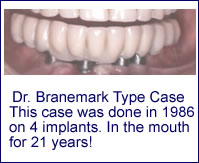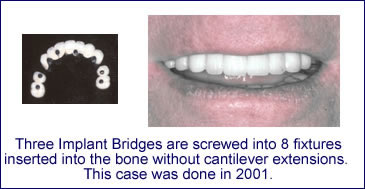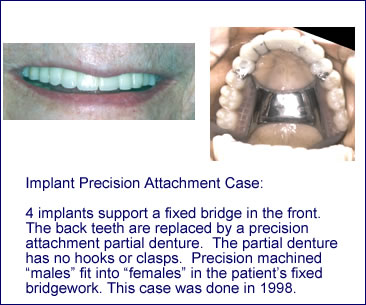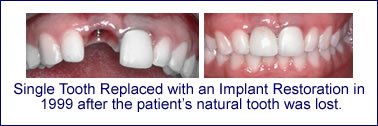I. Implant Restorations – Full Arch with Implants
A. Restoration with Fixed Bridgework
 Dr. Brånemark’s original research restored full edentulous (no teeth) arches to bicuspid occlusion. About 4 to 6 implants were placed in the anterior (front) region of the mouth. On the lower arch, the anterior region is the best area to place implants; and almost anyone can be a candidate for implants in this area. The posterior (back) region may present a problem placing implants depending upon the location of the inferior alveolar nerve. Very few patients are comfortable with a lower denture because the muscles of the tongue and cheek continually lift up the denture. Implants for the lower arch are a godsend for these patients. The early cases were mostly done in this area according to Dr. Brånemark’s recommendations.
Dr. Brånemark’s original research restored full edentulous (no teeth) arches to bicuspid occlusion. About 4 to 6 implants were placed in the anterior (front) region of the mouth. On the lower arch, the anterior region is the best area to place implants; and almost anyone can be a candidate for implants in this area. The posterior (back) region may present a problem placing implants depending upon the location of the inferior alveolar nerve. Very few patients are comfortable with a lower denture because the muscles of the tongue and cheek continually lift up the denture. Implants for the lower arch are a godsend for these patients. The early cases were mostly done in this area according to Dr. Brånemark’s recommendations.
When there is enough bone (or enough bone can be created), implants can give extra support to fixed bridgework, and the bridgework can be placed in sections for easy management in the event of breakage or loosening. Whenever possible, the screw holes are made accessible for this reason.

Full arch restorations can also be accomplished with a fixed anterior bridge and a posterior precision attachment partial denture. A precision attachment case on implants is much better than an overdenture on implants for several reasons:
B. Restoration with Fixed Bridgework/Removable Precision Attachment Partial Denture
Implants can also be used to create fixed bridgework in the front that can support a posterior precision attachment case to replace the back teeth.
A precision attachment case on implants offers these advantages:
- Less Surgery is Required. As few as three implants can restore an entire arch of teeth. More implants are required to create an entire arch of fixed bridgework
- Patients can Bite into Anything. Patients have a solid fixed front bridge that enables them to bite into any food. There are no front-back tipping forces as there may be with an implant overdenture.
- Increased Sense of Well-Being. The front teeth do not come out, contributing to the patient’s sense of well-being and self-esteem. The back removable bridge is comfortable and is only removed during hygiene.
- Less Coverage of Edentulous Tissues. The removable bridge covers far less of the palate than an overdenture. As a result, the removable bridge does not interfere with speech or cover taste buds in the front of the palate.

Read more…(Precision Attachments/Using Implants to Support Precision Attachments)
II. Restoration of Partial Arch with Implants
Implants can be used to restore areas of an arch where fixed bridgework on natural teeth is not possible or a poor investment in terms of longevity.

In this case (completed in 2004), fixed bridgework was created on natural teeth in the front after periodontal surgery. Two implant-retained fixed bridges were made to replace the back teeth
III. Restoration of Single Teeth with Implants.
The amount of bone and soft tissue are critical factors in the decision to place single tooth implants. The teeth surrounding the edentulous space must be in good condition–with few fillings and no periodontal bone loss. When the adjacent teeth are in good condition, the placement of a single tooth implant will prevent the need for drilling on teeth. However, if the adjacent teeth have large fillings that will require or already have crowns, it does not make sense to place single tooth implants. More predictable results can be obtained with conventional bridgework. Unlike a single tooth implant, bridgework can compensate for periodontal bone loss for the entire area, distribute the forces more evenly on the periodontal foundation, improve hygiene and prevent future.

